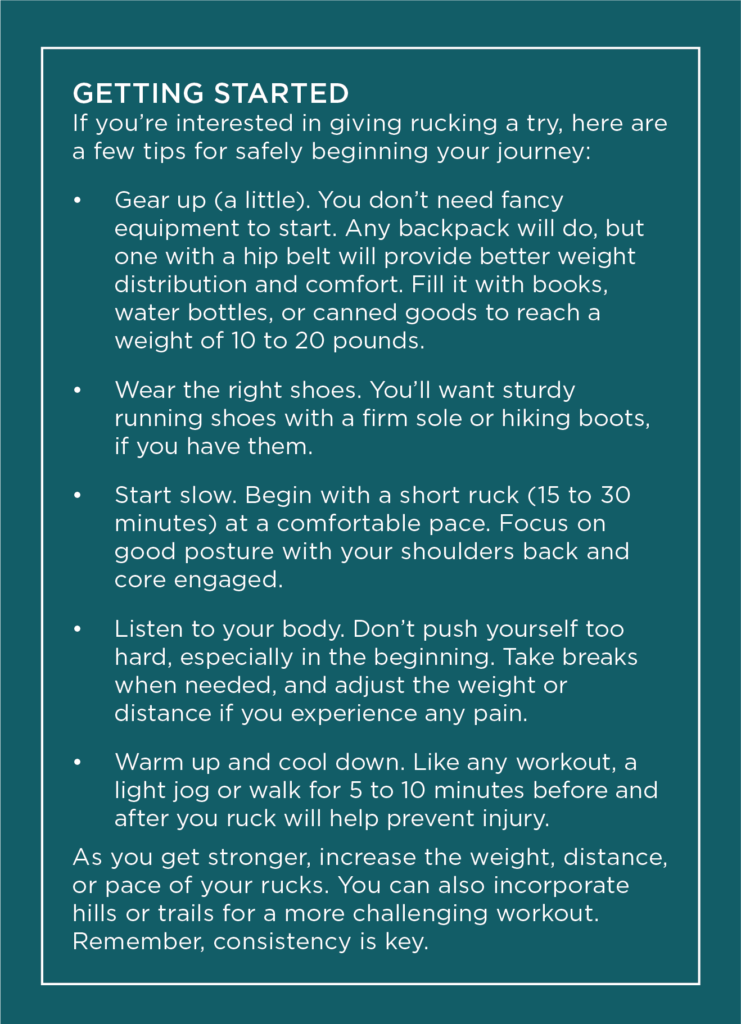Worth the Weight: Rucking for Strength and Endurance
Rucking is a form of weight-bearing aerobic exercise that has grown in popularity among fitness enthusiasts from weekend warriors to hard-core endurance athletes. Rucking is simply walking while wearing a weighted backpack, or ruck. The word ruck derives from the German word rucksack, meaning backpack.
Born to Ruck
Rucking has obvious connections to military training, where soldiers have long been required to carry heavy packs and march for extended periods, but its origins go back much further.

“The act of rucking has been happening since the hunter-gatherer period,” says Jason McCarthy, founder and CEO of GORUCK, the company credited with sparking the modern rucking movement. Indeed, humans’ ability to carry heavy things over long distances has been a necessary survival skill throughout evolution.
“People have been rucking in some way, shape, or form their entire lives,” says McCarthy. “They just haven’t noticed, or it hasn’t been intentional. Think of bringing in your groceries, walking to the bus stop with a bag full of books, or going to grab a coffee with your kid in a wearable baby carrier. They all ladder up organically to rucking.”
McCarthy founded GORUCK in 2008 to manufacture rugged backpacks designed for rucking and host endurance events centered on the activity. But success didn’t happen overnight. “When I first produced the GR1 [the company’s initial product], I didn’t sell any, and it was a reality check of how challenging the business world would be,” he says.
Today, McCarthy is optimistic about GORUCK’s future as people are becoming much more intentional about their relationship with and approach to rucking. “I believe that it will become bigger than running,” he says.
Low Impact, Many Benefits
A conversation with his doctor about his blood pressure and physical condition sparked Warren’s initial interest in rucking. “My doctor said, ‘I want you to start exercising and getting to the point where you’re having a little trouble breathing,’” he says. “Rucking really gets my heart pumping and thumping.”
While the concept of strapping weight to your back and going for a walk may seem simple, rucking offers a powerful combination of aerobic exercise and strength training that engages muscles throughout the body. It provides an exceptional full-body workout that improves cardiovascular fitness; builds muscle endurance; and strengthens the core, back, shoulders, and legs.
“Carrying weight while you walk engages muscles throughout your body in a way that regular walking doesn’t,” says Warren. “It’s low impact, but it’s been a very effective way for me to build strength and endurance.”
McCarthy concurs: “Because it’s low impact, it has fewer injury risks than something like running.”
In addition to the physical benefits, ruckers report significant mental health advantages. “It also promotes getting outdoors and getting into nature, getting exposed to sunlight and fresh air, which is great for your mental health,” says McCarthy. The rhythmic nature of rucking combined with being out in nature can reduce stress and anxiety.
Ruckers frequently report improved sleep quality and a sense of well-being after their sessions.
“Rucking is a great way to build community, and is, in my opinion, always best to be done with a group,” says McCarthy. “That could be several people in a ruck club, your spouse and kids, or taking your dog for a walk. Building a community through exercise and wellness is an incredibly powerful thing.”
The Right Stuff
While you can get started rucking with any backpack filled with weight, investing in proper rucking equipment can make a significant difference in comfort and safety, especially as you increase the weight and duration of your sessions.
“For someone starting out, I’d suggest they do it right and get good equipment out of the gate,” advises Warren. “Otherwise, you might hurt yourself or get frustrated, and you’re not going to pursue it any further. If you invest a couple hundred dollars in the right gear, you’ll take to it, and it’ll benefit you.”
GORUCK is one of several companies that offer backpacks designed for rucking. These packs feature padded hip belts and sternum straps to distribute weight evenly across the body, as well as durable construction to withstand the rigors of long-distance rucking. Ruckers add weights or sandbags to their packs to increase the load as desired to dial in their workouts.

Beginner to Marathoner
For those new to rucking, it’s best to start slowly and gradually increase the weight and duration of your sessions over time. “Start with [shorter distance], time, and weight, and work your way up,” says McCarthy. If you aren’t an avid gym-goer, 10 pounds is a good starting weight for women and 20 for men.
“I started with a 30-pound pack for 30 minutes, which is a common go-to for ruckers,” says Warren, whose other favorite physical activities include weightlifting and loading sound gear for the band he manages.
As you become more comfortable with the activity, you can increase the weight in your pack and the distance or time you ruck. Some experienced ruckers work their way up to carrying 40 to 60 pounds or more for extended periods, with some even taking on ultramarathon-distance rucking events.
Choosing a suitable route is also essential for an enjoyable and effective rucking experience. Look for routes with a mix of terrain and scenery. “My 30-minute route includes some quality nature time,” says Warren. “I’m walking through woods; there’s a substantial incline and a nice downhill stretch. It’s a good workout, but it comes easily and allows me to think.”
Rucking offers something for everyone, whether that’s a straightforward way to improve your fitness, a new challenge to push your endurance limits, or a means of achieving a greater sense of mental calm. With its accessibility and multitude of benefits, it’s no wonder this once-niche workout is growing into a widespread fitness phenomenon. “It gives me peace of mind that I’m doing something healthy and I’m enjoying the activity,” says Warren.
Article by John Curry